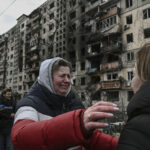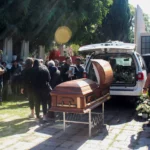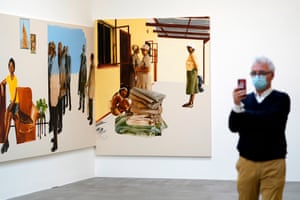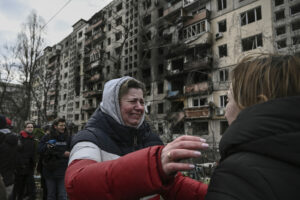Ayoung man, little more than a boy, hands draped superciliously over the sides of his chair and with one leg fastidiously crossed over the other, stares me down from behind his dark glasses. I’d ask him to stop staring but to either side of him stand two identikit bare-chested minders in low-slung jeans and flip-flops. The hired muscle doesn’t seem to like the look of me either. Behind them all hangs a cheesy picture of Jesus with the Sacred Heart and a photo of a guy – perhaps Dad? – in a military uniform. You just want to get out of there, or move on to the next painting in Meleko Mokgosi’s Bread, Butter, and Power, a 2018 cycle of 21 large painted panels, which abut one another in larger and smaller groupings, the largest of which fills the longest wall of the biggest gallery in Mokgosi’s first UK exhibition.
I could go on all day about this one group of paintings: a woman in a sumptuous if ugly salon, holding a paper in her hand – a letter, a bill, a poem, a shopping list, who knows? – and staring off into some self-absorbed distance. Uniformed schoolgirls dig a bit of parched earth, watched over by a man with several large dogs. A guy on a bed, fully clothed, resting after work, strong daylight filtered through a curtain; Mokgosi is very good at lassitude, solitude and introspection, and the sense of things impending. Soft shadows on the wall, a patterned pillow. The man looks back at us, as if we’ve walked in uninvited.
Your eye slides over the next panel, depicting an empty room. An ugly vase on a table, a view through an open door into a corridor where, framed by the doorway, hangs a small close-up photo of two hands, belonging to different people, handcuffed together. You want to get in there to take a closer look. You want to know why. This is one of many small pictures within Mokgosi’s bigger pictures, and which play multiple roles: jokes, warnings, clues, allusions and signposts, atmosphere.
Next, another scene, another bedroom. A woman dressed in black leather (perhaps biker gear) looks at herself in a dressing table mirror, her image split by the glass. She doesn’t know we’re there. Three uniform hats with chequered bands are hung from the mirror’s frame. I guess she is a police officer. She’s also being looked at by a little blond doll, sat tucked-up in the bed behind her.
The Botswana-born, US-based artist invites lengthy discourse. There are so many underpinnings, references, repetitions, delays and self-interruptions at work in his long cycles of images and painted words, his pictures-within-pictures, his historical allusions and verbal and visual quotations and critiques, that one is likely to be overwhelmed. He presents a fragmentary anatomy of life in rich people’s houses, in township homes, schools and marketplaces in southern Africa. What Mogkosi paints, the way he paints, the stories he tells, the complexities of his thinking and its underpinnings, his intellectual position and even why he covers his cotton duck and linen canvasses with a clear coat of primer rather than multiple layers of white acrylic gesso (the phrase “white primer” is loaded with associations), and how that both constrains his technique and also gives him certain freedoms and opportunities, are all connected. Not least, it affects the way he renders black skin, with all its nuances and tonal values.
The final panel on this wall is printed with a lengthy section of text, and accompanying footnotes, by the Indian intellectual Gayatri Chakravorty Spivak. Spivak’s thinking on democracy and post-colonialism have been extremely influential on Mokgosi’s own development, and especially in the grand cycle of his Democratic Intuition paintings, of which Bread, Butter, and Power forms but one chapter. Partly on account of their wide-screen horizontal spread, their dissolves and jump-cuts, their frame-by-frame progression from canvas to canvas, the bleeds between scenes, the heartbeat-long patches of emptiness and sudden frames filled with text, Mokgosi’s paintings borrow much from the language of cinema. But to me they also come close to big, discursive novels. Filled with life and observation, the main themes, characters and plotlines are frequently interrupted by digressions and self-interruptions.
Of course, what you can do on a canvas is different to what a novel or a movie can do. However predetermined, images have a way of escaping intention, and open themselves up to multiple readings and approaches. Some objects appear and reappear from painting to painting – a china dog, which he uses as a kind of theatrical prop (part a MacGuffin, like the Maltese Falcon, and also like one of those familiar jugs that recur in Cézanne’s still-lifes), and a sculpture of a standing naked black woman, whose feet have been damaged, revealing the armature beneath. There are probably others. Characters, or types, come and go: teachers, officials of one sort or another, politicians, the wealthy, maids, gardeners, farmers, military men and women, people with power and people with no power at all.
Some panels of text are in Setswana, a Bantu language. The artist has said that the lack of translation of the latter is a way of honouring the stories they tell, which come from an oral tradition. Are these texts meant to be read? Or looked at as paintings of texts? Mokgosi is dealing in levels of legibility, in ambiguity, in degrees of comprehensibility and accessibility. Different audiences will see different things. All his work, perhaps, is a kind of painted text, as all allegorical paintings are. Among other works there are a number of smaller canvases in which sections of contentious art history and catalogue essays are underlined, annotated and unpicked by the artist, mostly to show their inherently racist rhetoric. I don’t think these need to be paintings.
“I never romanticise being an artist,” Mokgosi has said. “I don’t do the whisky and cigarette at 3am.” His long cycles of interrelated paintings are the product of research and planning, before painting can even begin. And once it does, there is no revision or overpainting, no starting again. What you see is the final draft. The plainness of his way of painting, avoiding expression or excess, is itself deeply calculated, idiomatic and reserved. This plainness gives the illusion of accessibility, but it is a trap. It is the place where the complications really begin.
Source : The Guardian
















